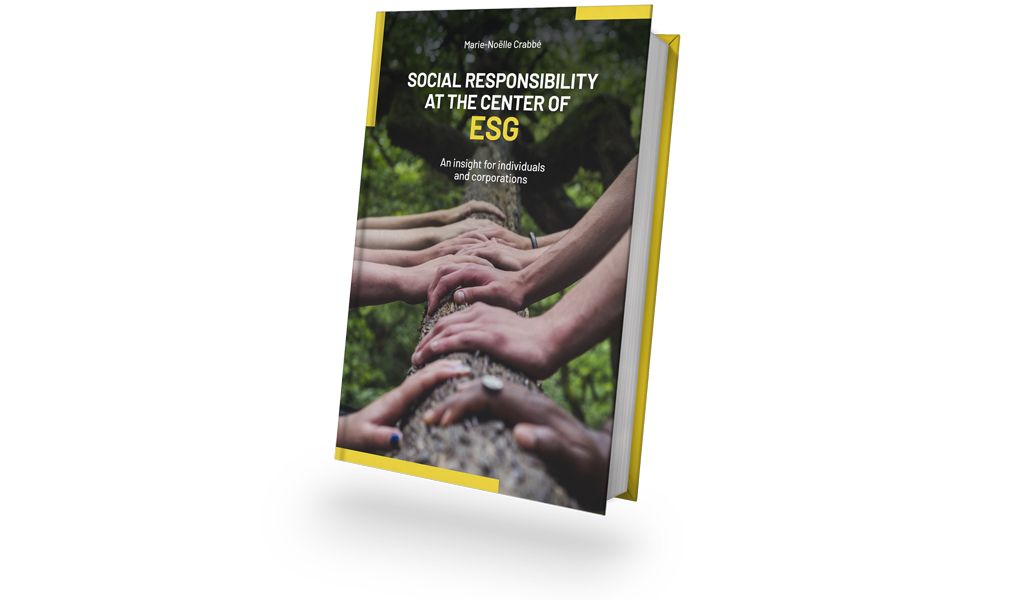SOCIAL RESPONSIBILITY AT THE CENTER OF ESG
An insight for individuals and corporations
Recently, ESG indicators have been used by job-seekers, increasing the interest for ESG criteria in some sectors. <b><em>Social responsibility at the center of ESG</em></b> introduces the social impact of these transformations and uses the ‘S’ in ESG as an employment strategy.

If you want to read an extract from the book Social responsibility at the center of ESG, please click on the button

About the author
Marie-Noëlle Crabbé
Marie-Noëlle Crabbé majored in business and held various management positions before graduating from Harvard University with a master’s in educational psychology. She practiced as a family therapist and specialized in conflict resolution, assisting corporate and humanitarian professional teams.
Marie-Noëlle became ISO 9001 and corporate social responsibility lead auditor in 2014 and received several ethical and CSR certifications. Hundreds of audit days carried out internationally provided her with ample grounds to analyze human behavior.
Marie-Noëlle lived and worked in Latin America, France and the United States before settling in Spain where she founded Imago International: www.imago-int.eu. She is the mother of three young professionals, and an avid traveler and photographer. Several of her photographs are included in her first book Journal of a social auditor.
Social responsibility at the center of ESG is Marie-Noëlle’s second publication, which has been submitted to publishers.
Contact: info@imago-int.eu
Know more about this publication
ESG gained attention because of the growing interest for sustainability. Consistent environmental, social and governance indicators are used throughout industries for ESG reporting. While some companies made substantial efforts to decrease their ESG-related risks, others still ignore what ESG entails, and why inaction may expose their business.
Recent research on the “S” in ESG did not offer homogeneous social options: the focus is on governance and the environment. Moreover, The Economist magazine (23 July 2022) stated that ESG efforts should solely focus on carbon emissions. This assumption dismisses the effort to harmonize corporate management and governance systems, discouraging social approaches. The article suggests that executives will tailor their social decisions in accordance with financial growth, within the framework of the law. This decision does not take into consideration the changes in workforces’ habits, including an aging population and the new generations’ employment requests.
The Covid-19 pandemic has exacerbated the issue around business sustainability while public and private institutions now measure their social and environmental risks beyond the sole financial value. To understand what is at stake, it is essential to understand the role of social responsibility within the ESG trilogy, and how business leaders and employees embrace the upcoming societal changes.
Anyone interested in ESG and its influence on social responsibility must read Social responsibility at the center of ESG. First, the book describes the environmental, governmental and social aspects of ESG illustrated by examples of CSR audits. Through the eyes of a social auditor, the focus is on the social side of ESG with an analysis of both the employer’s and employee’s perspectives. Social responsibility at the center of ESG may also be of interest to any business owner of manager of a small or mid-size company willing to understand ESG and implement social indicators.
Throughout this book, I reference a broad range of businesses that I visited as a CSR auditor, from slaughterhouses to food manufacturing plants, pharmaceutical and chemical plants, glass and plastic manufacturing facilities, French haute-couture fashion houses or human resources agencies. These companies employed anywhere from 20 to 4,500 workers. The audits offer a glance at various types of industries.
The privacy of companies and their employees is respected. The interest stems from the situations emerging during the audit, when my involvement as an auditor offered an insider’s look at industries that are otherwise out of the public eye.

